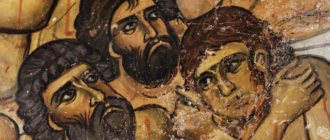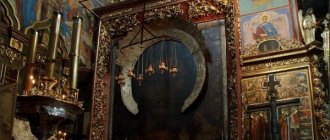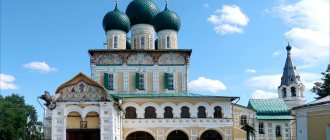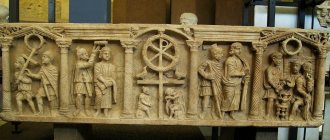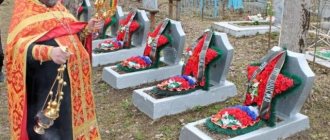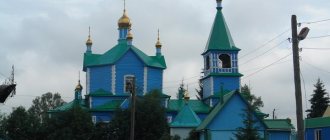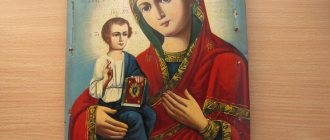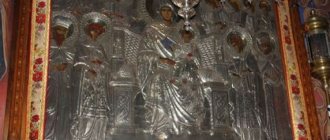The image of the “Sinai Savior on the Throne” is an icon that is the prototype of the oldest Orthodox icon - the Lord Pantocrator. The icon from the Temple of the Twelve Apostles was painted in the extremely rare and most complex technique of “encaustic”; the paints are applied to a wax primer using heated copper sticks - as if it were soldered inside. Thus, the picture becomes more vibrant and voluminous due to the relief. In addition, thanks to the encaustic technique, the colors never fade - they remain bright forever.
The icon “Lord Pantocrator from the Sinai Monastery” is the oldest shrine from the mid-6th century, which was destined to survive to this day. The original was created in Constantinople. Emperor Justinian donated it to the monastery of Santa Catarina, located on the Sinai Peninsula.
History of the icon “Savior on the Throne”
According to legend, the first icon of the Savior was not made by hands. There are several recollections that Jesus washed his face with water and then wiped it with an ubrus (handkerchief), and his bright face appeared on it. For many years, artists were forbidden to paint the Lord. And only in 787, at the Seventh Ecumenical Council, was the veneration of icons officially permitted.
The image of Jesus on a throne, wearing a crown, with an open Gospel on his knee appeared around the 9th century in the Byzantine Empire. Russian masters learned icon painting from the Byzantine ones, so that each work of church art complied with strictly established canons and carried a deep sacred meaning. And yet, Russian icons are distinguished by their brightness; they are saturated with vibrant and sonorous color. Only in the 12th century did “The Lord on the Throne” decorate churches in Russia.
Of all the images of the Lord Jesus Christ presented in the church, believers heartily honor the “Savior on the throne.” The Son of God is depicted in full growth, he sits majestically on the Divine throne, symbolizing royal power. For the Lord is the Pantocrator, the Heavenly King of all visible and invisible, of the entire Universe, his throne is higher than the earthly. The thoughts, deeds, good and sinful deeds of every person are open to Him.
The Son of God looks with love from the icon, but his gaze is incorruptible and stern, like that of a loving parent. The Supreme Priest of the church and the Almighty at the Last Judgment is impassive, but wise and fair. And he is the deliverer of immortal righteous souls at the end of all time. The halo around the Savior indicates the Divine glory and shining light.
The tunic of the King of Heaven on the icon is most often painted red, and the himation is blue. Shades of red symbolize martyrdom and royal dignity. Blue represents heavenly purity. The right hand raised up blesses all believers. Shadows are never reflected on icons, since the Celestials themselves are light.
Old Russian images of the Savior are found not only in Christian churches in Russia. Some of them belong to museums, for example:
- “The Savior on the Throne,” painted in Novgorod in the 15th century, is owned by the State Tretyakov Gallery.
- In the Assumption Cathedral of the Moscow Kremlin, the central part was occupied by the icon “The Savior on the Throne” by Kirill Ivanovich Ulanov. Nowadays it is under the jurisdiction of the State Tretyakov Gallery.
- The icon “The Savior on the Throne with the Present Mother of God and John the Baptist” belongs to the State Hermitage.
- The icon of the Rostov school “Christ Pantocrator on the Throne,” painted in the 16th century, is exhibited at the Andrei Rublev Central Museum of Ancient Russian Culture and Art in Moscow.
Jesus in iconography
The icon, being “theology in color,” seeks to reflect the dogmatic understanding of the Savior. It is in the light of dogma that the canonical Orthodox image of Christ should be interpreted. The icon depicts the always risen Christ, from within whom divine light shines. Even if the image is a plot one, which depicts the Savior’s lifetime deeds, it still shows not the earthly Jesus, but the resurrected one. Therefore, an icon is always metahistorical; it reveals the spiritual essence of an event or person, and does not record physical reality. Ultimately, the image is entirely a symbol. And each element in it is a reflection of its spiritual root. It would be fair to say that the icon depicts the indescribable and shows the invisible. All these features are included in the icon of the Lord Pantocrator. Its meaning is determined by the Greek term “Pantocrator”, which means “owning everything, ruling everything, having power over everything, omnipotent.”
Meaning in Orthodoxy
Jesus Christ is one of the main images in Christian iconography. Having accepted martyrdom, he did not lose his all-encompassing love for people. “The Savior on the Throne” is revered by the church, like other icons of the Pantocrator. It reminds of Heavenly Court, repentance and the importance of good deeds in people's lives.
The clergy advise all believers to have such an icon in their home. The image of the Lord is intended to remind followers of the Christian church of Divine love and the sacrifice that the Savior made for the salvation of all mankind.
Those who pray turn to the Lord in any, even very difficult situations:
- sincerely ask for forgiveness for sins committed in earthly life;
- thank Spas for his help and support;
- they pray for healing from fatal illnesses and mental wounds;
- ask for relief from mental and emotional disorders;
- they call on mercy for salvation from melancholy, despondency, anxiety, despair;
- They seek in prayers consolation, instructions on the true path, protection from deception, slander, and lies.
They pray not only for themselves, but also for their loved ones.
Prayer before the icon of Jesus Christ
“Our Father” is the prayer that is read most often. But there is another prayer that Christian believers pray:
Oh, Merciful and Mighty King of Heaven, Son of the Lord Jesus Christ! You sacrificed Your life, saving the human race from torment and suffering. Thank you, our Savior, for not leaving us in difficult moments. Hear our prayers, for we lift up our words to You! Do not leave us in sorrow and troubles, deliver us from anger and selfishness, give us will and perseverance. Heal from mental and physical illnesses. Guide us on the true path, forgive us our sins and give us Your blessing. We pray before Your most holy icon, You alone are our support and protection! Protect our children and our homes from enemies and adversity! Be near and do not leave us until the end of our days. We repent and ask forgiveness from You, Son of God, and from the Lord, Your Father, for all our sinful actions and thoughts. Deliver us from suffering and become our earthly patron! We will never cease to honor and glorify Your image! May we praise Your name, Son of the Lord, Jesus Christ! Let Your will be done. In the name of the Father, and the Son, and the Holy Spirit. Forever and ever. Amen
Christians ask the Saint for protection from malice, heartlessness and meanness. Orthodox Christians also thank their Savior in order to receive His blessing in their new endeavors.
Believers turn to God's saints with the hope of a miracle and salvation, but by turning to Jesus Christ, who is accompanied by Faith, Power and Love, they will receive healing instantly.
Days of celebration
The icon of the “Savior on the Throne” is in every church; it is honored on official days marked in the calendar of the Orthodox Church:
- August 14 - on this day the Dormition Fast begins, the church remembers the All-Merciful Savior and the Most Holy Theotokos;
- August 19 – celebration of the Transfiguration of the Lord God in front of his disciples on the top of Mount Tabor, the holiday is popularly called the Apple Savior;
- August 28 – honoring of the Most Holy Theotokos, Assumption of the Ever-Virgin Mary, end of Lent.
Description of the Pantocrator type
Actually, the icon “Lord Pantocrator” is not even an icon, but an iconographic type of image of Christ. According to canonical norms, the Savior is presented in it in the form of a reigning person. The pose can be different - he can stand or sit on the throne. Belt and shoulder-length options for the look are also popular. The icon “Lord Pantocrator” is immediately recognizable by the position of Christ’s hands. In his left he holds a codex, which symbolizes his preaching - the gospel. And the right hand is most often folded in a blessing gesture. In general, this is the most common and recognizable iconographic type of the Savior. It has been known since about the fourth century. And the oldest icon “Lord Pantocrator” today is an image from the Sinai monastery of the sixth century.
What does it help with?
Since Christ is the embodiment of God in man, you can turn to Him with absolutely any request. During his earthly journey, the Savior healed many sick and possessed people. He suggested how to properly build your spiritual life, how to behave towards loved ones. All of this is still true today because God never changes.
How does the icon “Lord Almighty” help?
- Gives a blessing before starting an important task.
- Brings relief from ailments.
- Promotes spiritual growth.
- Before it you can offer prayers of thanks and read the Psalter.
- This image is given after the wedding as a family heirloom.
- You can read prayers in front of it for loved ones who are in trouble.
Daily prayers (in the morning and before bed) are also performed in front of the face of Christ, who is depicted in this image. Such an icon would be an excellent gift for any believer - for example, for baptism or Easter. Don’t forget and thank God for what you have, even if it seems like it’s not enough. You need to accustom your heart to gratitude, and remember that human greed has no limits if it is encouraged.
What did God look like?
An icon is not a portrait. The Gospel itself does not give an unambiguous description of the appearance of Jesus Christ. The Lord left it a secret for subsequent generations. However, the canonical appearance that people see on the icons of Christ the Pantocrator is not at all accidental, it is not the fantasy of icon painters. History has preserved very ancient images and descriptions of contemporaries.
The heroes of the New Testament perceived the appearance of the Savior as the most ordinary; they did not see anything special or supernatural in it. Christ himself hid the Divine glory so as not to frighten those around him, revealing it only a few times (on Mount Tabor and during baptism).
An important literary source is a letter from the proconsul of Judea, where Christ is attributed to tall stature, brown hair, smooth skin, a red forked beard, and blue sparkling eyes. The manner of conversation is described as calm and very pleasant. The author of the description recognizes the entire appearance of the Savior as “most beautiful.”
In the first centuries, Christians depicted Christ allegorically - in the form of a fish, a lamb, a pelican, a dolphin, a lamb with an anchor. In the 7th century, however, such drawings were prohibited by a resolution of the Council.
Frescoes close to the orthodox ones appeared in the catacombs during the period of Roman persecution. Today's traditions of depicting Christ Pantocrator on icons developed in the 6th century, although a number of images date back to Gospel times.
Revered images of the "Pantocrator" type
In conclusion, it is necessary to recall that the image is not Christ himself, and that any of them, including the “Lord Pantocrator”, is an icon. The 19th century somewhat downplayed the importance of personal spiritual discipline and practice, with the result that the church community still suffers from the disease of the pursuit of miraculous images. As an example of such a revered icon of the Savior, one can cite the 14th century image of Eleazarovsky, now kept in the monastery of the same name in the Pskov diocese.
Most Orthodox Christians have several (or many) icons at home. People believe that each of them can help with a specific problem. According to church rules, the first and most important icon to be purchased is the icon of the Lord Almighty. She alone can replace all the others - because God is the only one who creates miracles, it was He who breathed life into the first people, He continues to create the universe every day.
